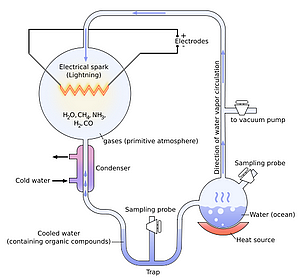ORIGIN AND HISTORY OF LIFE
For the AP Test and the scope of this class, this chapter is minimal.
Discuss the major evolutionary milestones and significant events that shaped life on Earth from its origins to the present day. In your response, address the key adaptations, major life forms, and the impact of environmental changes on the diversity of organisms. Use specific examples and evidence to support your explanation.
Reference: Chapter 20 (Openstax)
Key Ideas
1. The origin of living systems is explained by natural processes.
The process of evolution explains the diversity and unity of life. A number of experimental investigations have provided evidence that the conditions early in the Earth’s history provided an environment capable of generating complex organic molecules and simple cell-like structures.
The Miller-Urey experiment showed that the elements found in the atmosphere could have combined to create the building blocks for life.
- The “organic soup” model, the hypothesized primitive atmosphere contained inorganic precursors from which organic molecules could have been synthesized through natural chemical reactions catalyzed by the input of energy.
Monomers --> Polymers --> amino acids and nucleotides
Self replicating molecules spontaneously assemble (we can also observe this in a lab)
It is unknown if the first self replicating molecule was DNA or RNA
The RNA World hypothesis suggests the earliest genetic material was RNA
Sequence
1. Monomers
2. Macromolecules (polymers)
3. Membrane
4. Self Replication (DNA or RNA)
2. The Earth is Very Old
From meteorites and other dating methods, scientists estimate the earth to have formed about 4.6 billion years ago
The fossil record shows an orderly appearance of the different forms of life on the planet with humans arriving fairly late on the scene.
Fossils that appear in older layers existed a long time ago, newer layers are more current.
We do not see dinosaur fossils in new layers, nor do we see them in the same layers as humans - this is how we know dinosaurs and humans did not exist at the same time.
The first life forms were prokaryotes, which appeared about 3.5 bya
The appearance photosynthetic organisms resulted in more oxygen in the atmosphere
Eukaryotes appeared at about 2 bya
The first multicellular organisms about 1 bya
The fossil record shows periods of time that were dominated by specific forms of life, these periods end with mass extinctions. Examples:
Devonian Period - Age of Fishes (~358 mya)
Cretaceous Period - the last period before dinosaur extinction
Quaternary Period - current time, Age of Mammals
3. Organizing Life on Earth
Each organism shares relatedness with others, and based on morphologic and genetic evidence, scientists attempt to map the evolutionary pathways of all life on Earth. H
istorically, scientists organized organisms into a taxonomic classification system. However,
Test Prep
The AP Test will likely test your understanding that natural processes resulted in life on earth and that these processes have been confirmed through experiments.
The AP test will also test your understanding that the earth is very old, and that the fossil record and dating methods can be used to determine when organisms appeared on the planet (and when they became extinct)
Sample Questions
1. Explain the significance of the fossil record in understanding the history of life on Earth. Discuss how fossils form, the different types of fossils, and how they provide insights into evolutionary relationships and past environments. Provide specific examples to support your explanation.
2. Compare and contrast relative dating and radiometric dating methods used in determining the age of fossils. Discuss the strengths and limitations of each method and how they contribute to our understanding of the timeline of life on Earth. Support your answer with examples of how these dating techniques have been applied in paleontological studies.
3. Describe the major transitions in life forms from the Paleozoic to the Cenozoic era. Discuss the key evolutionary innovations during each era and how they contributed to the diversification of organisms. Include specific examples of significant organisms and their adaptations during these periods.
4. Examine the concept of transitional fossils in evolutionary biology. Define what constitutes a transitional fossil and discuss the role they play in illustrating evolutionary pathways. Provide examples of well-known transitional fossils and explain how they contribute to our understanding of evolutionary relationships between different species.
5. Discuss the impact of mass extinction events on the history of life on Earth. Explain the major mass extinctions, their probable causes, and their effects on biodiversity. Analyze how these events have shaped subsequent evolutionary trajectories and the recovery of life after each extinction event.
